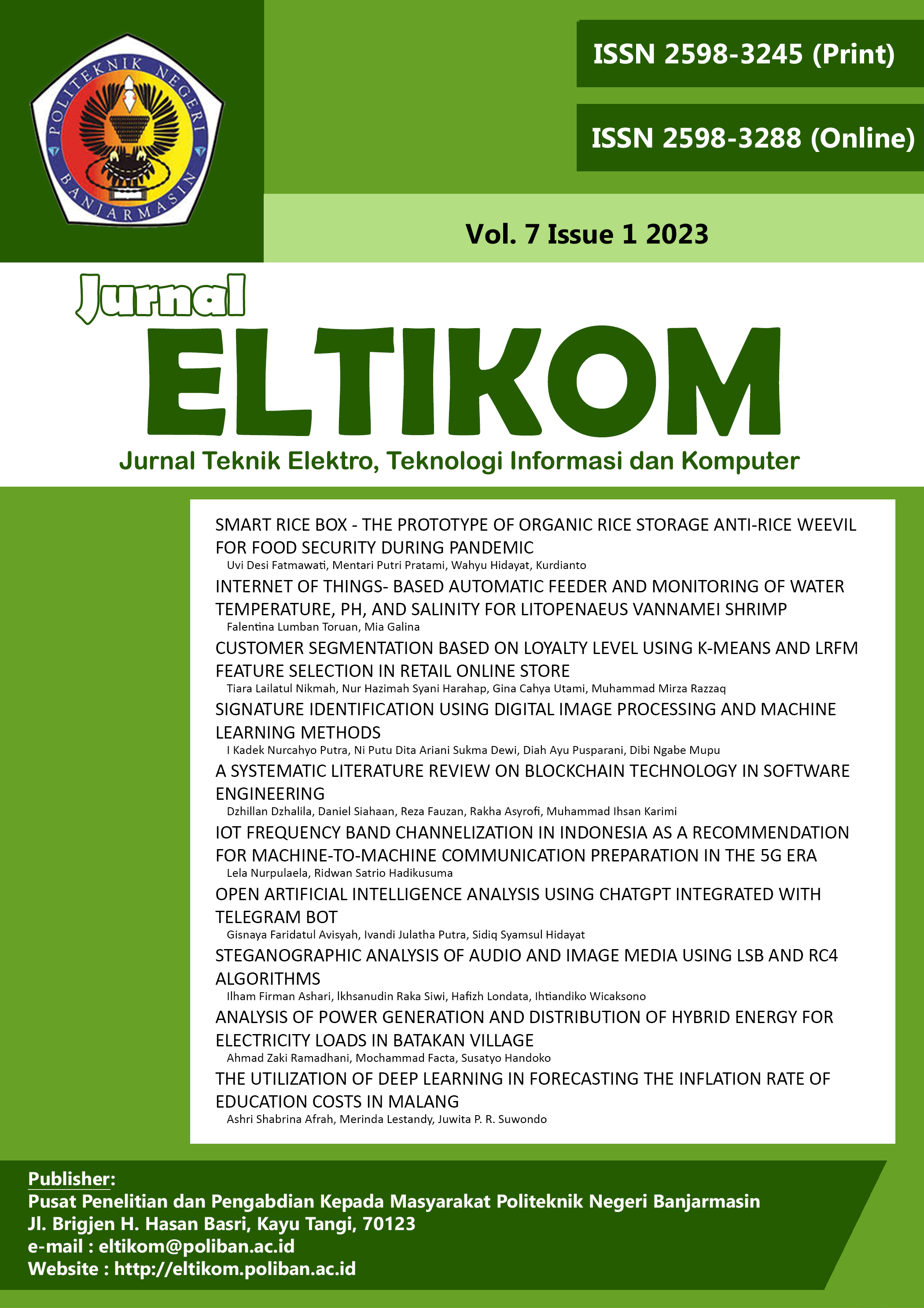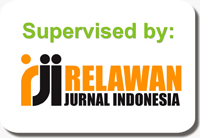Smart Rice Box - The Prototype of Organic Rice Storage Anti-Rice Weevil for Food Security during Pandemic
DOI:
https://doi.org/10.31961/eltikom.v7i1.604Keywords:
organic rice, prototype, raspberry pi, Sytophilus Oryzae L, UV lightAbstract
The need for organic rice among the people continues to increase in line with the declining level of public health due to the COVID-19 pandemic. Consuming organic rice is one way to maintain body immunity, but organic rice is susceptible to attack by Sitophilus Oryzae L, a type of rice weevil which is the main pest in postharvest commodities. Proper storage of rice is one way to address food security during a pandemic. In this study, a prototype of an anti-rice weevil (Sytophilus Oryzae L) organic rice storage was made using a Raspberry Pi controller and several additional sensors such as a camera sensor and temperature and humidity sensors. UV Hydroponic Lamp and LED Grow Light are used to reduce the growth rate of rice bugs during storage. The results showed that the whole system was running well and the rice bugs on rice were drastically reduced within 36 hours and 18 minutes of storage.
Downloads
References
Kementerian Pertanian RI, “Beras Organik Indonesia Diminati Pasar Ekspor,†2019. https://pertanian.go.id/home/index.php?show=news&act=view&id=3907 (accessed Feb. 10, 2022).
R. D. Mastuti, S. Subagiya, and R. Wijayanti, “Serangan Sitophilus oryzae Pada Beras Dari Beberapa Varietas Padi dan Suhu Penyimpanan,†Agrosains J. Penelit. Agron., vol. 22, no. 1, pp. 16–20, 2020.
E. Pranita, “Pandemi Ancam Krisis Ketahanan Pangan, Apa yang Harus Dilakukan?,†Kompas.com. https://www.kompas.com/sains/read/2020/11/02/190300423/pandemi-ancam-krisis-ketahanan-pangan-apa-yang-harus-dilakukan-? (accessed Feb. 10, 2022).
M. S. Gultom, M. Sarwoko, and A. N. Jati, “Sistem Monitoring Beras pada Rice Box Berbasis Mikrokontroler,†Universitas Telkom, 2012.
C. S. N. A. Karisma, “Rancang Bangun Smart Rice Box dengan Sistem Penakar Beras Berdasarkan Kebutuhan Porsi Makan,†2018.
W. A. Julian, “Rancang Bangun Alat Penakar Beras Otomatis Menggunakan Android Berbasis Mikrokontroller.†Politeknik Negeri Sriwijaya, 2016.
M. Hanif, M. Abdurohman, and A. G. Putrada, “Rice consumption prediction using linear regression method for smart rice box system,†J. Teknol. dan Sist. Komput, vol. 8, no. 4, pp. 284–288, 2020.
F. Aulia, “SitoTec, Alat Pendeteksi Hama Sitophilus Oryzae pada Biji-bijian dengan Menggunakan Sensor Piezoelektrik: Desain dan Implementasi Website.†Universitas Gadjah Mada, 2020.
R. W. Mankin, E. Jetter, B. Rohde, and M. Yasir, “Performance of a low-cost acoustic insect detector system with Sitophilus oryzae (Coleoptera: Curculionidae) in stored grain and Tribolium castaneum (Coleoptera: Tenebrionidae) in flour,†J. Econ. Entomol., vol. 113, no. 6, pp. 3004–3010, 2020.
X. Shao, C. Ding, P. Jitendra, and Q. Zhang, “Detection of hidden insect Sitophilus oryzae in wheat by low-field nuclear magnetic resonance.,†Julius-Kühn-Archiv, no. 463, pp. 1029–1037, 2018.
A. Simon, “Implementasi Metode Color Model Filtering HSV Untuk Mendeteksi Bola Pada Robot Sepak Bola Beroda.†Universitas Sumatera Utara, 2018.
D. J. Bora, A. K. Gupta, and F. A. Khan, “Comparing the performance of L* A* B* and HSV color spaces with respect to color image segmentation,†arXiv Prepr. arXiv1506.01472, 2015.
A. F. Hastawan, R. Septiana, and Y. E. Windarto, “Perbaikan hasil segmentasi hsv pada citra digital menggunakan metode segmentasi rgb grayscale,†Edu Komputika J., vol. 6, no. 1, pp. 32–37, 2019.
F. Islami, “Implementation of HSV-based Thresholding Method for Iris Detection,†J. Comput. Networks, Archit. High Perform. Comput., vol. 3, no. 1, pp. 97–104, 2021.
A. K. Panggabean, A. Syahfaridzah, and N. A. Ardiningih, “Mendeteksi Objek Berdasarkan Warna Dengan Segmentasi Warna HSV Menggunakan Aplikasi Matlab,†METHOMIKA J. Manaj. Inform. Komputerisasi Akunt., vol. 4, no. 2, pp. 94–97, 2020.
Y. S. Hariyani and A. Novianti, “Perancangan Aplikasi Pembaca Warna Dan Bentuk Berbasis Pengolahan Citra Untuk Daftar Katalog Perpustakaan,†eProceedings Appl. Sci., vol. 4, no. 3, 2018.
K. A. Draz, M. I. Mohamed, R. M. Tabikha, A. A. Darwish, and M. A. Abo-Bakr, “Assessment of some physical measures as safe and environmentally friendly alternative control agents for some common coleopteran insects in stored wheat products,†J. Plant Prot. Res., pp. 156–169, 2021.
K. Shibuya, S. Onodera, and M. Hori, “Toxic wavelength of blue light changes as insects grow,†PLoS One, vol. 13, no. 6, p. e0199266, 2018.
A. A. Bakr, “Effectiveness of ultraviolet radiation as a physical method in controlling the stored product mite, Tyrophagus putrescentiae (Acari: Acaridae),†J. Entomol, vol. 10, pp. 43–48, 2013.
D. A. Collins and L. Kitchingman, “The effect of ultraviolet C radiation on stored-product pests.,†Julius-Kühn-Archiv, no. 425, pp. 632–636, 2010.
S. I. Faruki, D. R. Das, and S. Khatun, “Effects of UV-radiation on the larvae of the lesser mealworm, Alphitobius diaperinus (Panzer)(Coleoptera: Tenebrionidae) and their progeny,†Pakistan J. Biol. Sci., vol. 5, no. 4, pp. 444–448, 2005.
S. Lou, X. Jiang, W. Sun, W. Zeng, L. Pagani, and P. J. Scott, “Characterisation methods for powder bed fusion processed surface topography,†Precis. Eng., vol. 57, pp. 1–15, 2019.
A. C. Bovik, The essential guide to image processing. Academic Press, 2009.
H. Singh and H. Singh, “Advanced image processing using opencv,†Pract. Mach. Learn. Image Process. Facial Recognition, Object Detect. Pattern Recognit. Using Python, pp. 63–88, 2019.
doxygen, “Smoothing Images,†2021. https://docs.opencv.org/4.5.3/dc/dd3/tutorial_gausian_median_blur_bilateral_filter.html (accessed Feb. 10, 2022).
L. Tan and J. Jiang, Digital signal processing: fundamentals and applications. Academic Press, 2018.
Downloads
Published
How to Cite
Issue
Section
License
Copyright (c) 2023 Jurnal ELTIKOM : Jurnal Teknik Elektro, Teknologi Informasi dan Komputer

This work is licensed under a Creative Commons Attribution-NoDerivatives 4.0 International License.
All accepted papers will be published under a Creative Commons Attribution 4.0 International (CC BY 4.0) License. Authors retain copyright and grant the journal right of first publication. CC-BY Licenced means lets others to Share (copy and redistribute the material in any medium or format) and Adapt (remix, transform, and build upon the material for any purpose, even commercially).




